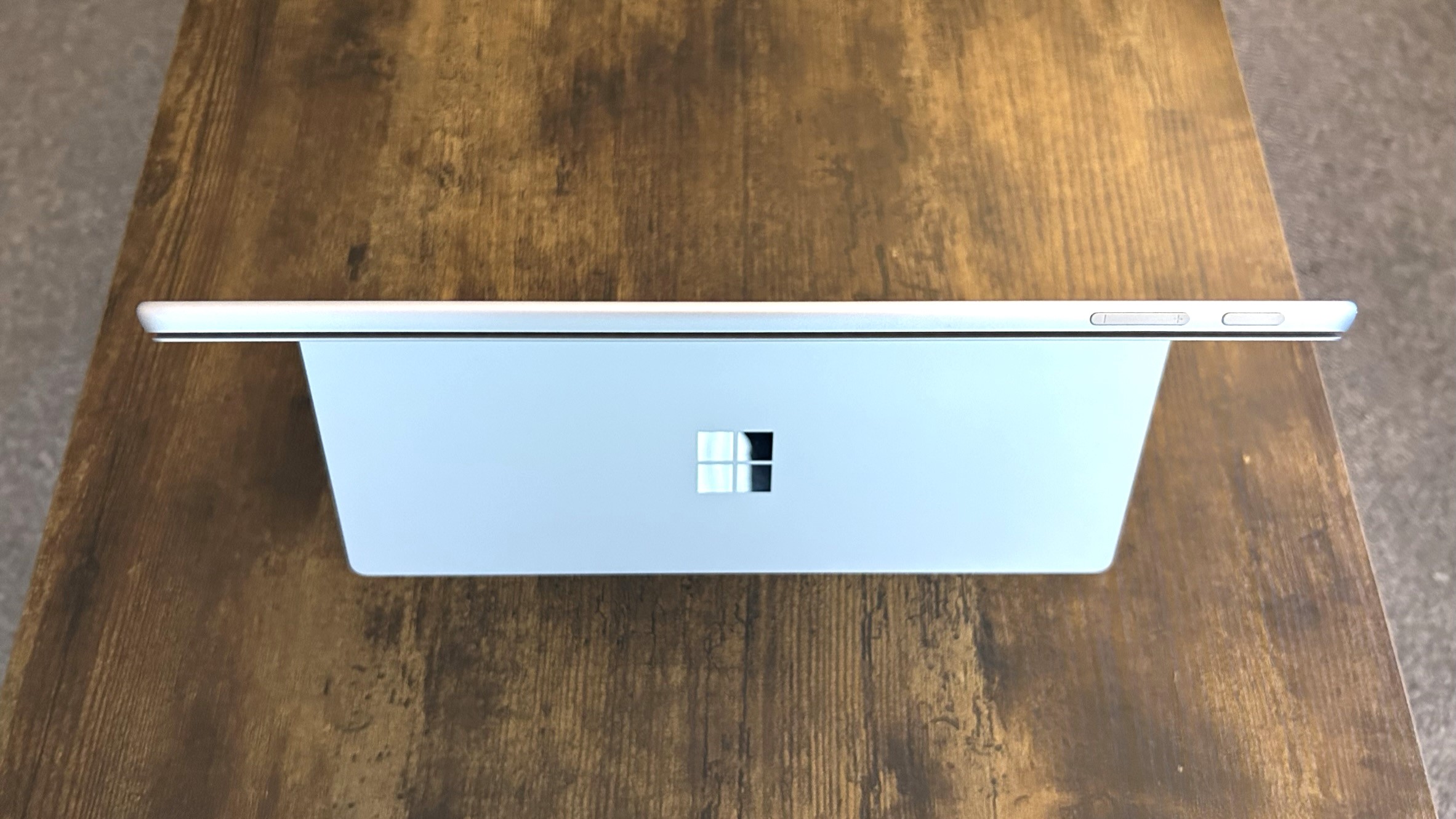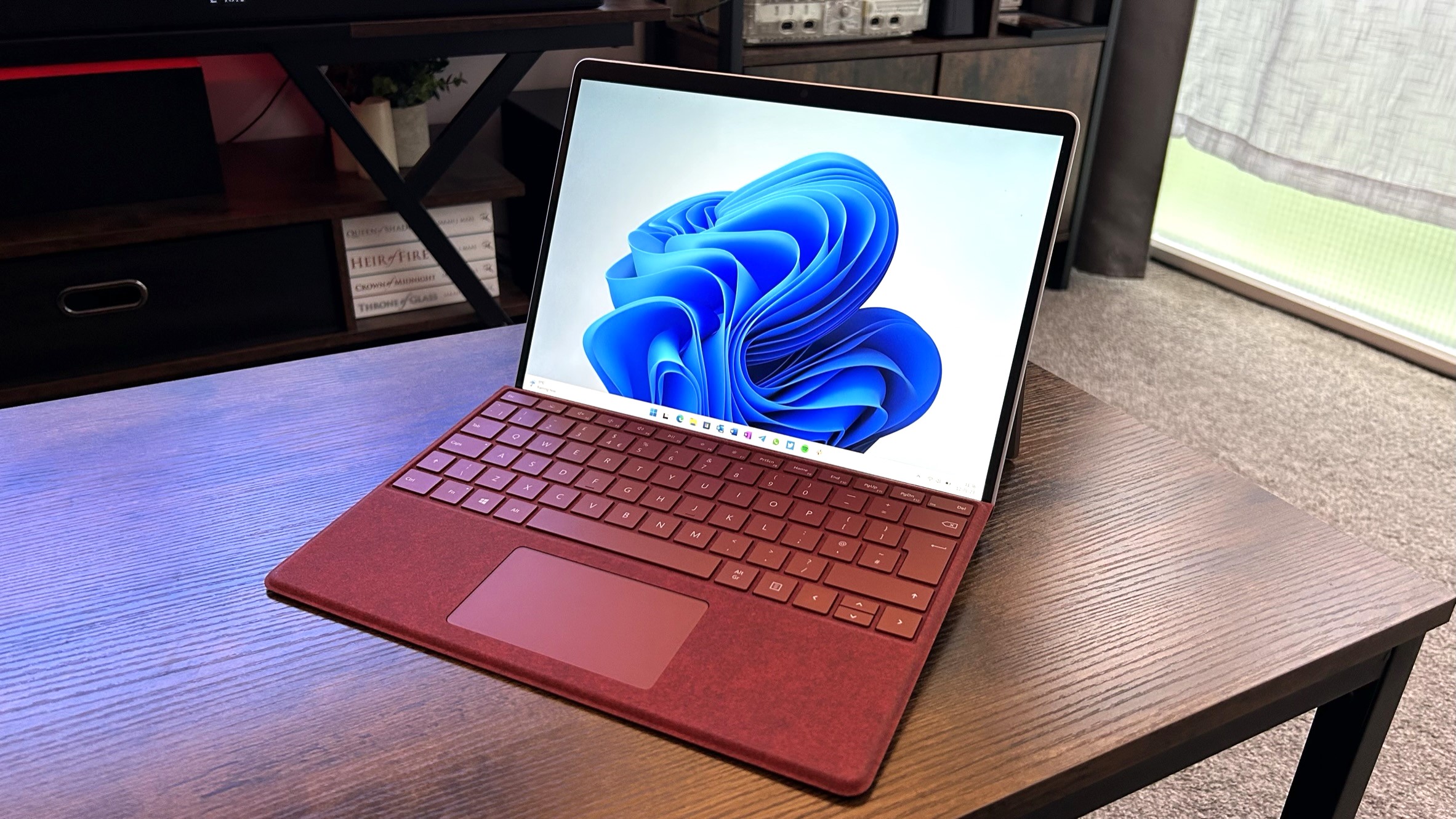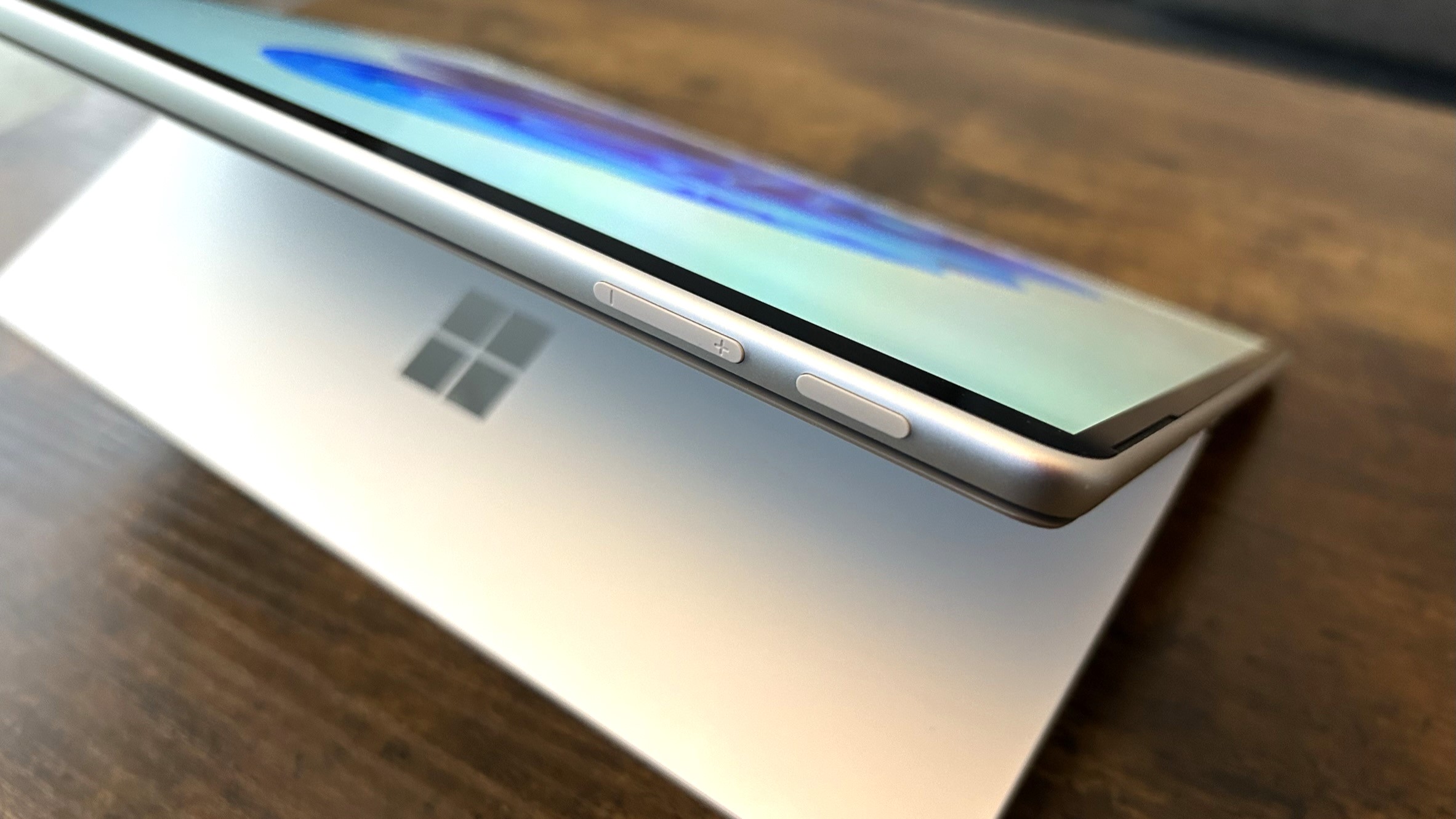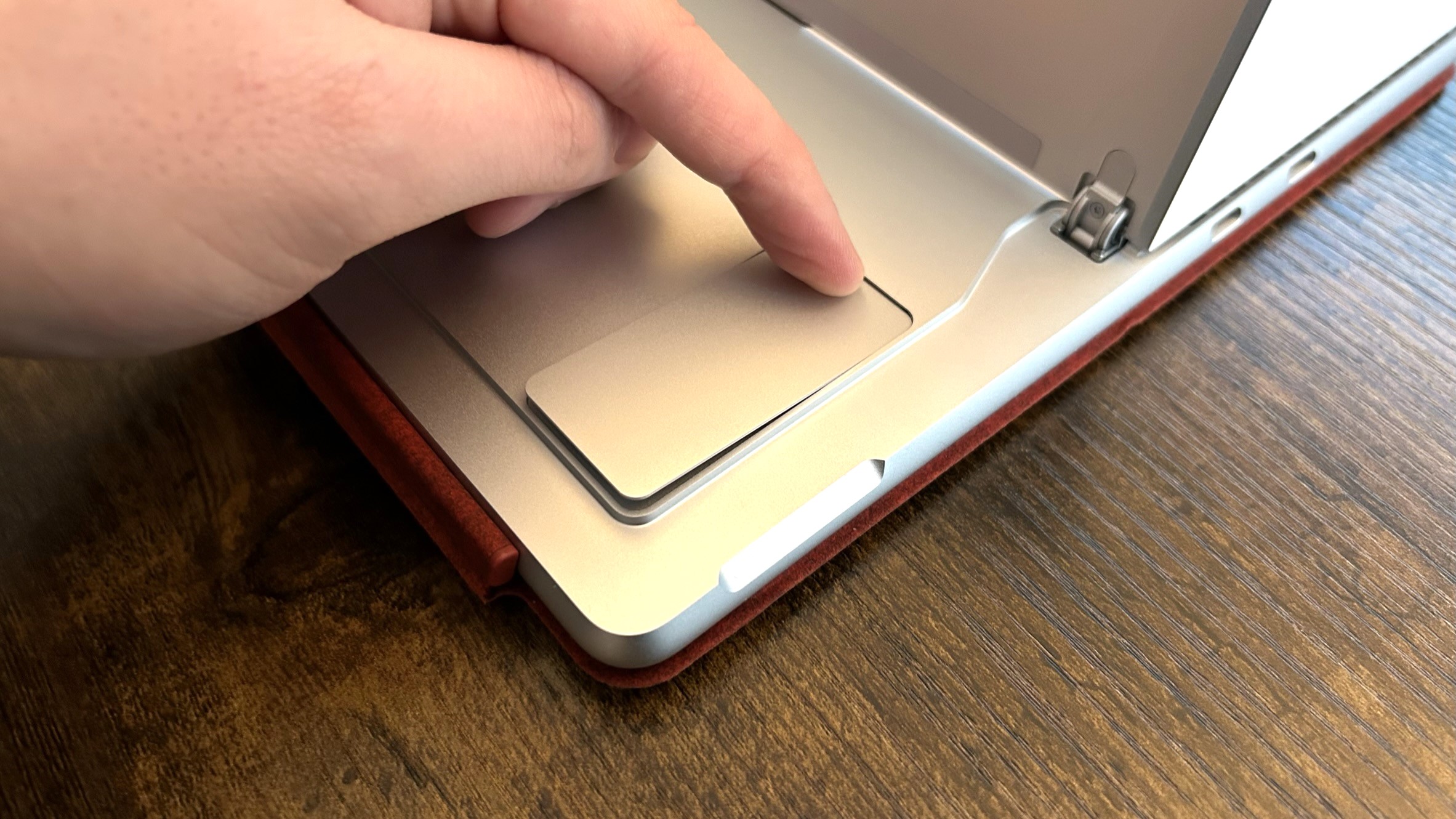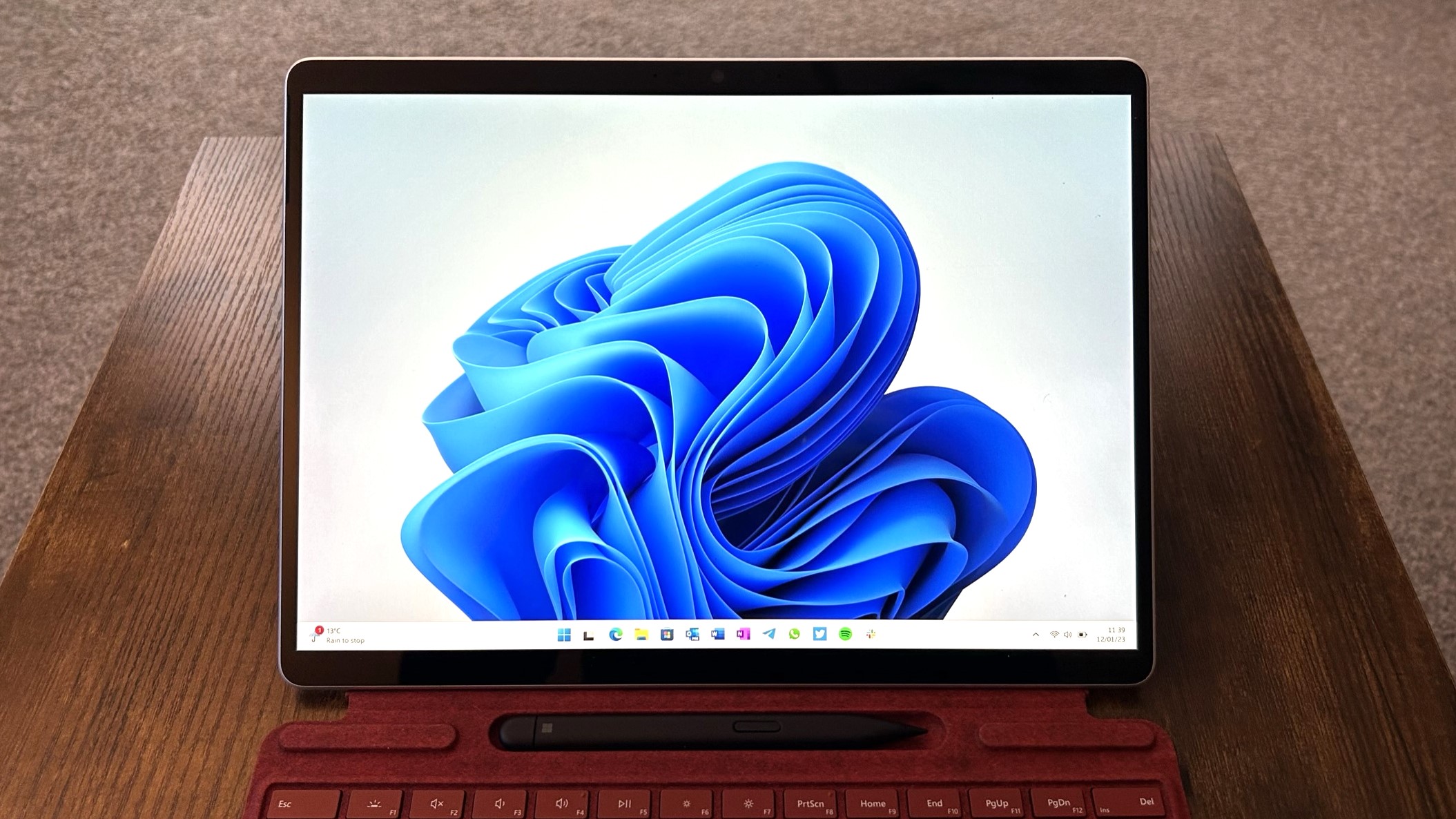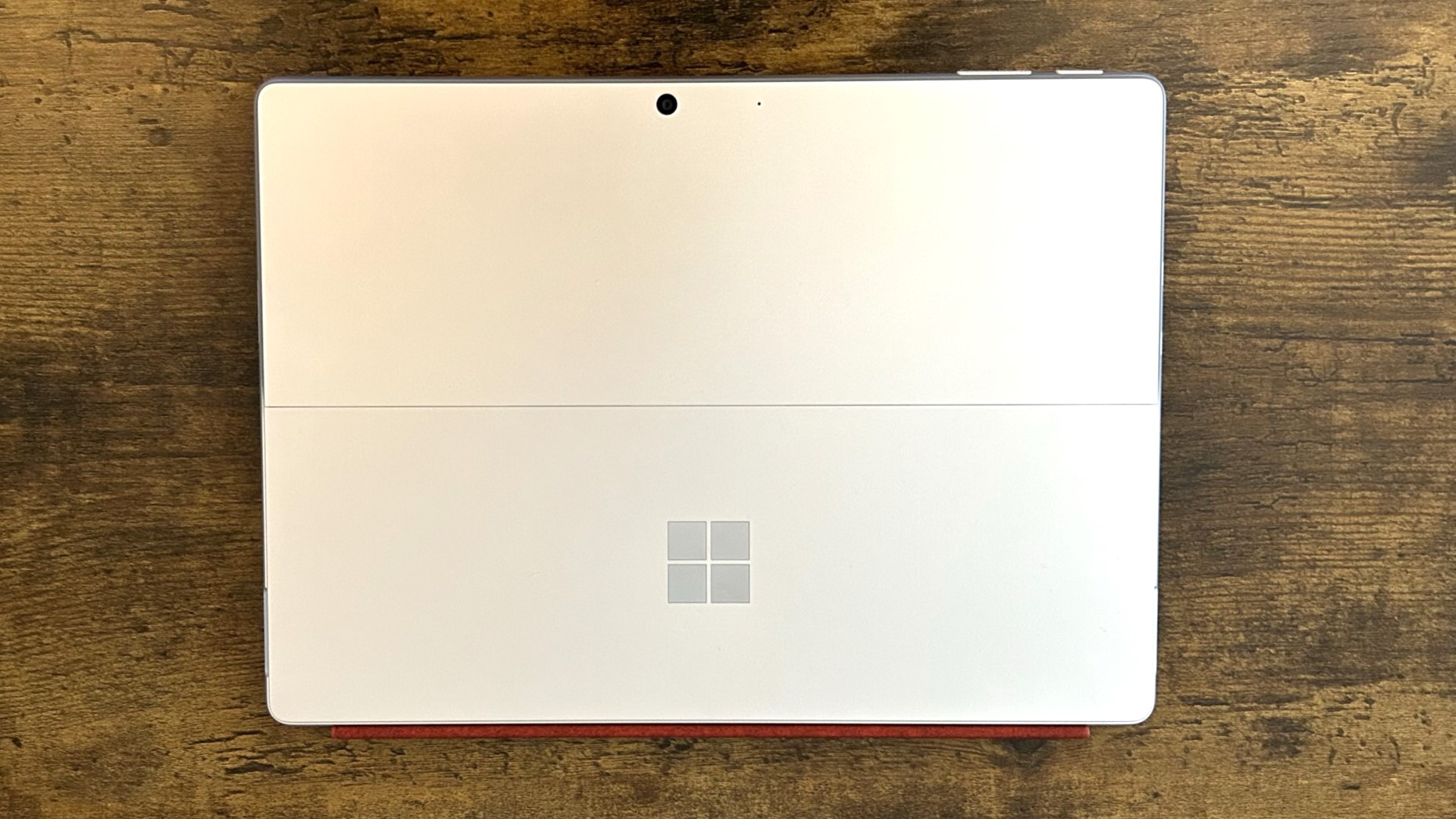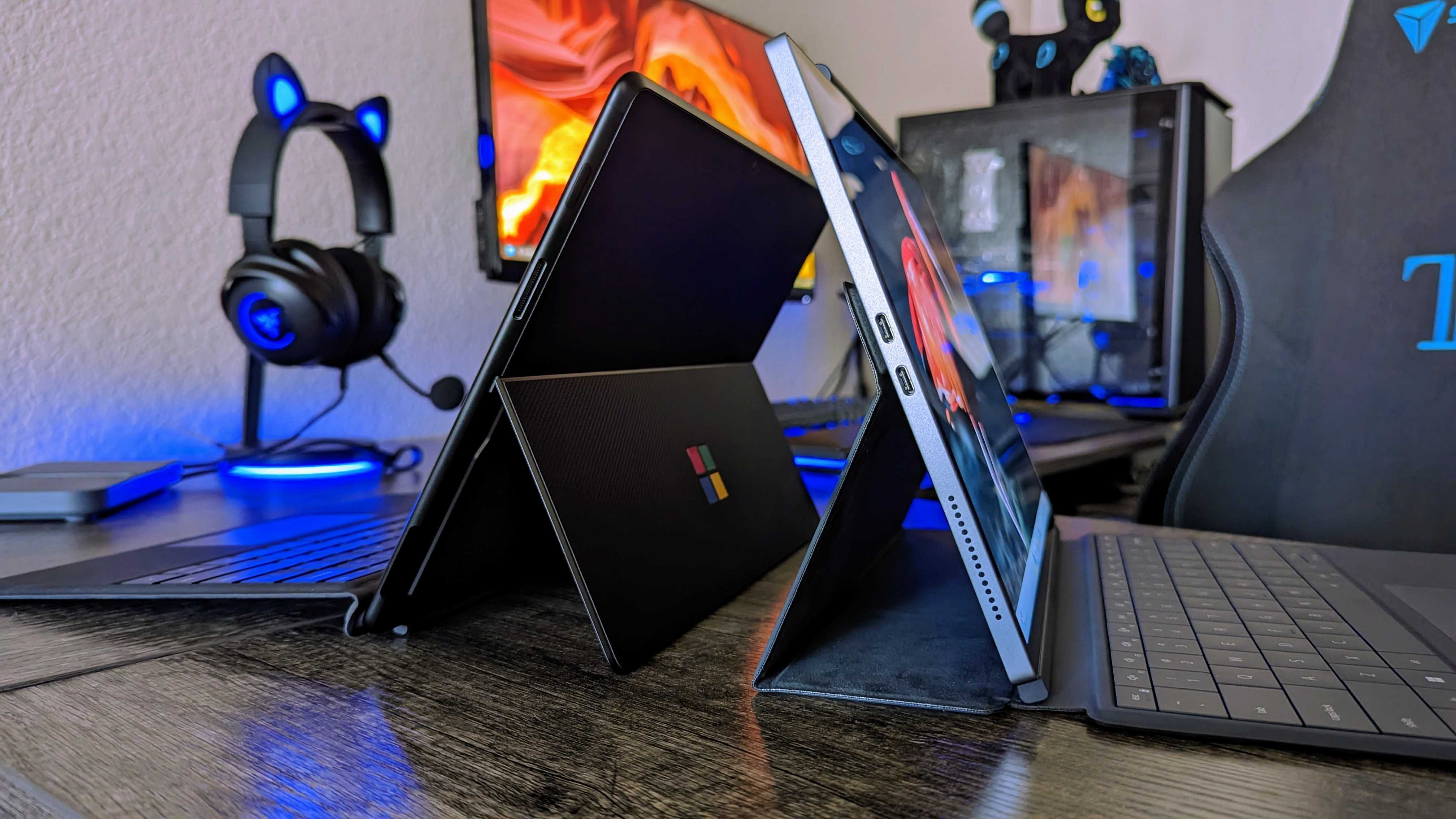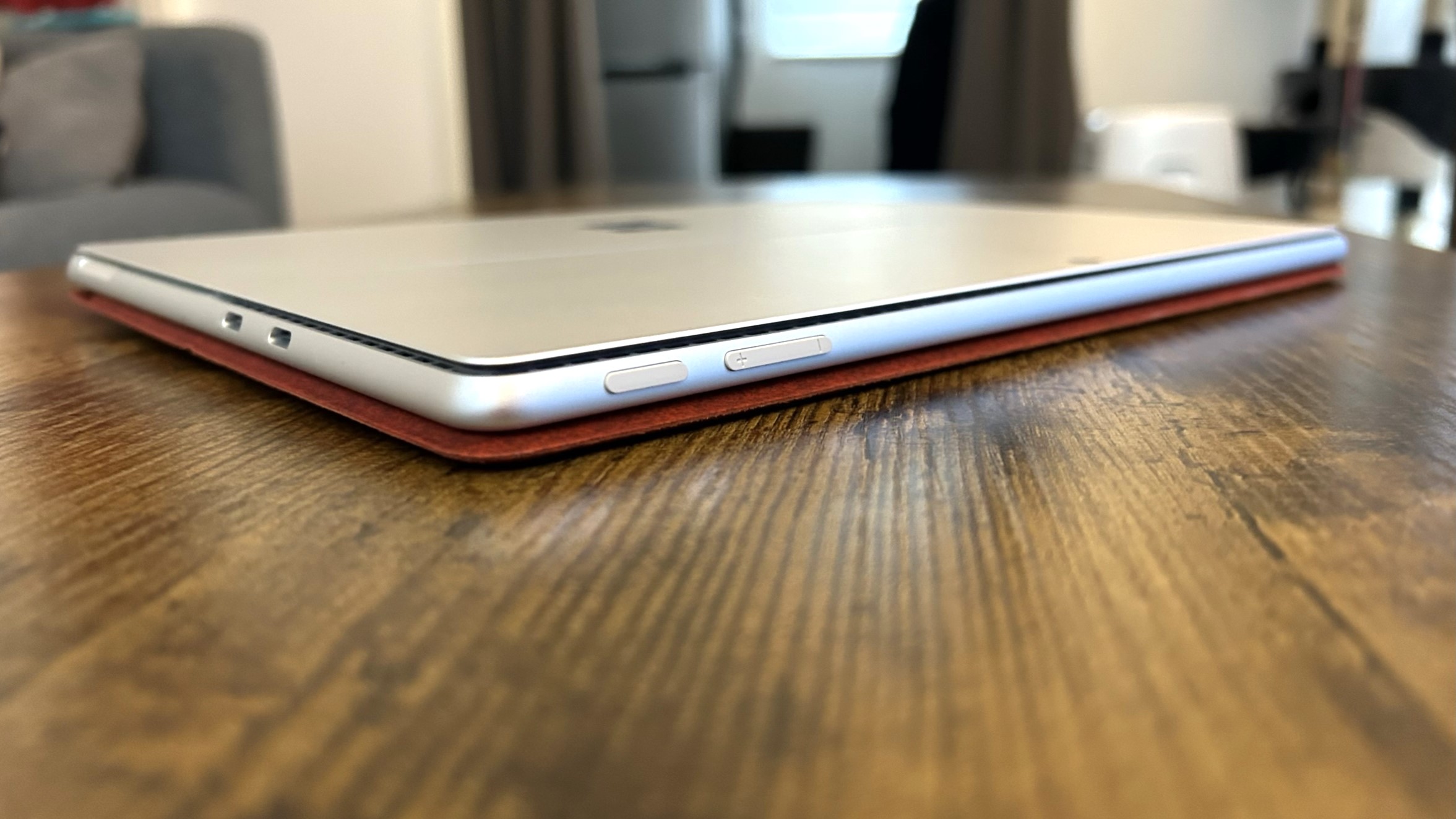Windows Central Verdict
The Surface Pro 9 is what 10 years of product refinement looks like. Almost everything about the Surface Pro 9 is perfect, down to the small aesthetic choices made to an iconic design.
Pros
- +
Beautiful design
- +
Great performance
- +
Fun new colors
- +
The best Surface Pro to date
Cons
- -
Battery life could always be better
- -
Type Cover sold separately
Why you can trust Windows Central
November 4, 2024: Ensured the review still matches our editorial standards and updated terminology and wording around availability. The device is still available to buy in new and refurbished configurations, and I still recommend it if you can find a good deal.
When the Surface Pro 9 was released, it marked 10 years of the Surface 2-in-1 form factor, and boy could you tell. I was never a huge fan of this form factor when it first launched, as I didn't feel like it could "replace your laptop" as Microsoft said it would. But ten years later, with a lot of form factor refinement under its belt, I think Microsoft finally did it with the Surface Pro 9.
The Surface Pro 9 is excellent in almost every way, even in 2024. It's so good, in fact, that I gave it a full 5/5, and to this day, I think it's the best piece of hardware Microsoft has ever released. It is only superseded by the newer Surface Pro 11, which utilizes the same design but with updated, more powerful, and energy-efficient chips.
But, should you still buy one in 2024? That depends entirely on whether or not you can find a good deal on one. As it's an older generation device, you should be able to save many hundreds of bucks on a refurbished or used model and come away with a great experience!
Surface Pro 9: Availability and specs
In 2024, the Surface Pro 9 is still available to buy directly from Microsoft, but only as a refurbished device. Microsoft's refurbished store is actually excellent, with each device being thoroughly inspected before being resold. These devices are often given new casings and batteries and are given a 1-year manufacturer warranty as well. Right now, prices for a refurbished Surface Pro 9 from Microsoft start at around $636, which is a great deal.
You can also still find the Surface Pro 9 new from third-party retailers like Amazon, which currently sell the Surface Pro 9 with an Intel Core i7 with 16GB RAM for around $970. That's a bit more expensive but still a great price for that specific configuration, which would've cost somewhere closer to $1,500 when new. Keep in mind, the Surface Pro 9 doesn't come with the Type Cover or pen accessories, so those are additional costs you'll need to consider.
| Header Cell - Column 0 | Surface Pro 9 | Surface Pro 9 with 5G |
|---|---|---|
| OS | Windows 11 Home | Windows 11 Home |
| Processor | 12th Gen Intel, Intel Evo | Microsoft SQ3 |
| Row 2 - Cell 0 | Core i5-1235U, Core i7-1255U | Row 2 - Cell 2 |
| RAM | 8GB, 16GB, 32GB LPDDR5 | 8GB, 16GB LPDDR4x |
| Graphics | Intel Iris Xe | Microsoft SQ3 Adreno 8CX (Gen 3) |
| Storage | 128GB, 256GB, 512GB, 1TB | 128GB, 256GB, 512GB |
| Row 6 - Cell 0 | Removable SSD | Removable SSD |
| Display | 13 inches, 2880x1920 (267 PPI), touch, 3:2 aspect ratio | 13 inches, 2880x1920 (267 PPI), touch, 3:2 aspect ratio |
| Row 8 - Cell 0 | Up to 120Hz (dynamic refresh rate), Dolby Vision | Up to 120Hz (dynamic refresh rate) |
| Pen | Surface Slim Pen 2 (Sold separately) | Surface Slim Pen 2 (Sold separately) |
| Ports | Two Thunderbolt 4, Surface Connect | Two USB-C 3.2, NanoSIM, Surface Connect |
| Audio | Dual 2W speakers, Dolby Atmos, dual far-field mics, Voice Clarity | Dual 2W speakers, Voice Clarity, Windows Studio Effects, dual far-field mics |
| Wireless | Wi-Fi 6E, Bluetooth 5.1 | Wi-Fi 6E, Bluetooth 5.1, NanoSIM, eSIM, 5G, mmWave, Sub-6 |
| Camera | Front-facing 1080p, IR camera, rear-facing 10MP (4K video) | Front-facing 1080p (Windows Studio Effects), IR camera, rear-facing 10MP (4K video) |
| Security | TPM 2.0, Windows Hello IR camera, Windows 11 Secured-core PC | Microsoft Pluton, Windows Hello IR camera, Windows 11 Secured-core PC |
| Battery | Up to 15.5 hours | Up to 19 hours |
| Dimensions | 11.3 x 8.2 x 0.37 inches | 11.3 x 8.2 x 0.37 inches |
| Row 17 - Cell 0 | (287mm x 208.3mm x 9.4mm) | (287mm x 208.3mm x 9.4mm) |
| Weight | 1.94 pounds (879g) | mmWave: 1.95 pounds (883g) |
| Row 19 - Cell 0 | Row 19 - Cell 1 | Sub-6: 1.94 pounds (878g) |
| Color | Platinum, Graphite, Sapphire, Forest | Platinum |
Surface Pro 9: Intel vs ARM
Before we get into the weeds of this review, it's important to highlight the differences between the normal Surface Pro 9 and the Surface Pro 9 with 5G. The TL;DR is the Surface Pro 9 with 5G ships with an ARM processor, known as the Microsoft SQ3 and based on the Qualcomm Snapdragon 8cx Gen3.
The Microsoft SQ3 is more energy efficient but less powerful compared to the Intel 12th-Gen i5 and i7 chips found in the non-5G Surface Pro 9. This means the Surface Pro 9 with 5G will have better battery life at the expense of performance. While the 5G variant isn't slow, you will want the Intel model if you plan on doing any demanding tasks.
All the latest news, reviews, and guides for Windows and Xbox diehards.
The Surface Pro 9 with 5G will also run many applications under emulation, as a lot of Windows apps haven't yet been updated to fully support Windows on ARM. Apps that run under emulation will vary in performance, but you will notice them running slower compared to an app that natively supports ARM.
Lastly, the Surface Pro 9 with 5G has additional AI features that the Intel Surface Pro 9 misses out on thanks to the Microsoft SQ3's additional "neural processing unit" (NPU), which can handle AI effects for the camera and webcam. The Intel model doesn't have an NPU and therefore does not have these features.
There are also minor design changes between both models. The 5G model doesn't have open holes for venting, as there's no internal fan due to the SoC being passively cooled. The SSD door under the kickstand is toolless on the Intel Surface Pro 9 but still requires a tool on the 5G model, as that's where your SIM card is stored.
The antenna on the 5G model is also much more noticeable, with small plastic lines surrounding the entire chassis to ensure good 5G connectivity. The Intel model has no obvious antenna lines.
And obviously, the Surface Pro 9 with 5G includes 5G capabilities for always-connected computing. The Intel model is not available with mobile data, so if that's something you need, the Surface Pro 9 with 5G is your only option.
This review focuses on the Intel model, though I do make comparisons to the 5G model where appropriate.
Surface Pro 9: Design and ports
The Surface Pro 9 continues to use Microsoft's "new" 2-in-1 design that was first introduced with the Surface Pro X back in 2019 and adopted by the main Surface Pro line with the Surface Pro 8. There have been some minor changes to the external design, specifically with the positioning of the ports and buttons around the chassis.
On the Surface Pro 8, the USB-C ports were on the right, along with the Surface Connect port. Starting with the Surface Pro 9, the USB-C ports have moved to the left side, and the Surface Connect port has moved slightly higher up on the right. The USB ports on the Intel model are Thunderbolt 4 capable, and only USB 3.2 Gen 2 capable on the 5G model.
Additionally, Microsoft has moved the volume and power buttons to the top of the device when in landscape mode, and they are now both found on the left.
I much prefer this button placement, which matches that of the older Surface Pro 7+ and prior. It means the buttons still make sense when using the Surface Pro 9 as a tablet in portrait mode. On the Surface Pro 8, using the device like this would mean the power button is on the bottom edge of the device, which makes no sense.
Now, with the Surface Pro 9, the volume and power buttons are positioned at the top right when in portrait mode and the top left when in landscape mode. The moving of the ports and buttons isn't the only design change taking place with the Surface Pro 9 either.
Microsoft says it has fully redesigned the Surface Pro 9's internals to make the device more repairable to help reduce its carbon footprint. There are even more replaceable components in the Surface Pro 9 compared to its predecessor, including the battery, display, kickstand, speakers, heatsink, fan, and more.
Sadly, Microsoft doesn't yet sell these replaceable components to end-users, though the company says it plans to in the coming months. Microsoft's focus on making the Surface Pro 9 more repairable for users is a great step forward in making the Surface Pro more eco-friendly.
Another small design change is with the SSD door located underneath the kickstand. It's now toolless, meaning you can open the door without the need for a SIM ejection tool. Just press down at the top of the SSD door, and it should pop right open. The door on the 5G model still requires a SIM tool, as that's also where the SIM card is stored.
Also new with the Surface Pro 9 is the introduction of two new colorways; Sage and Sapphire (aka green and blue.) For 10 years, the Surface Pro has only been available in either black or silver models, so it's nice to see some fun new colors join the fray.
The last thing I want to highlight about the Surface Pro 9's design is its antenna design or lack thereof on the Intel model. Previous Surface Pro models included a plastic strip somewhere on the chassis to allow wireless signals to pass through the body. On the Surface Pro 8, this was along the top of the chassis.
With the Surface Pro 9, Microsoft has removed that plastic antenna entirely. The plastic strip that ran along the top is gone, which makes for an all-aluminum chassis and looks excellent. Of course, the antenna still needs to be here somewhere otherwise wireless performance would suck.
Well, it looks like Microsoft has combined the antenna with the volume and power buttons, being as they are the only plastic parts of the design remaining. The result of doing this means the design looks antenna-less, even though it isn't. The same cannot be said for the Surface Pro 9 with 5G.
5G requires a lot more antennas to function, which means Microsoft had to add lots of small antenna strips around the entire Surface Pro 9 5G chassis, which I really dislike compared to the antenna-less design of the normal Surface Pro 9. It even looks worse than the LTE-powered Surface Pro X, but this is what's required for good 5G performance.
Surface Pro 9: Display and features
The Surface Pro line has always featured a gorgeous display, and that trend continues here with the Surface Pro 9. Like the Surface Pro 8, we have a 120Hz 13-inch display with a resolution of 2880 x 1800 for a PPI measurement of 192. This means images and text render beautifully with a native 200% scaling in Windows.
New to the Surface Pro 9 is the ability for the display to dynamically adjust its refresh rate between 60Hz and 120Hz, just like the Surface Laptop Studio. The dynamic aspect comes into play when scrolling in apps and webpages, moving app windows around, and inking using the Surface Slim Pen 2, which is still sold separately.
This new dynamic refresh rate option is supposed to help save battery life, as not running at a full 120Hz all the time reduces power consumption. In reality, it doesn't make much of a difference. I found battery life to be middling in both dynamic and 120Hz modes.
The Surface Pro 9 also includes Dolby Vision, a form of HDR (high-dynamic range) that enhances contrast in video content. There's also Dolby Atmos support, which offers virtual surround sound in supported content. Both picture and audio quality on the Surface Pro 9 are fantastic, with punchy colors, deep blacks, and clear audio to boot.
The Surface Slim Pen 2 is also fully supported with the Surface Pro 9, which includes haptic feedback in supported apps. Sadly, there haven't been any further improvements to pen accuracy when inking on the display. While the infamous "wobbly line" issue was improved with the Slim Pen 2 and Surface Pro 8, it doesn't seem like there have been any further improvements with this generation.
Microsoft often includes excellent webcams on Surface devices, and the Surface Pro 9 is no exception. Image quality is clear in well-lit environments, and microphone quality is great thanks to its included dual-array mic setup. The webcam also includes Windows Hello facial recognition, which authenticates nice and fast.
On the subject of the webcam and microphone, this area differs quite dramatically between the normal and 5G versions, thanks to the silicon differences between Intel and ARM. The Surface Pro 9 with 5G includes an additional processor known as a neural processing unit (NPU) and can handle complex AI tasks.
Windows 11 features AI effects for the webcam and microphone, and the Surface Pro 9 with 5G takes advantage of these. AI features include background blur, eye correction, and automatic framing, along with voice focus and clarity to enhance your voice when in loud environments.
I should also mention that the Surface Pro Type Cover is still sold separately. It's a costly accessory at $150, but one I think is required to make the most of the Surface Pro. It's super-premium, covered in Alcantara fabric, and comes in fun colors, including Red, Blue, Green, Black, and Platinum, and also has a built-in charging dock for the Surface Slim Pen 2.
Surface Pro 9: Performance and battery
If the Surface Pro 9 delivers one thing over its predecessor, it's performance. My review unit ships with an Intel Core i7-1255U processor, which is an excellent Ultrabook class chip that's a huge upgrade over Intel 11th-gen.
Intel's 12th Gen processors underwent a major architectural shift with a big.LITTLE design, which is similar to ARM. So, instead of 4 cores (8 threads) found in the 11th-Gen Intel Core i7 chip on the Surface Pro 8, the Surface Pro 9's 12th-gen Intel Core i7-1255U gets 10 cores (12 threads) at 2.60 GHz.
Because of this, the Surface Pro 9 is capable of much more demanding tasks, especially ones that require extra CPU horsepower. I found the Surface Pro 9 to be more than capable of heavy Photoshop work, crunching data, and even basic 4K video editing with no hiccups. It's even able to host our podcast livestream, which would not have been possible just a couple of years ago.
It does get warm to the touch, and you will hear the fan when you're pushing it to its max, but 95% of the time, the Surface Pro 9 is running cool and quiet. For common tasks like working in Office, video calling, browsing the web, and handling email, the Surface Pro 9 never overheats or throttles.
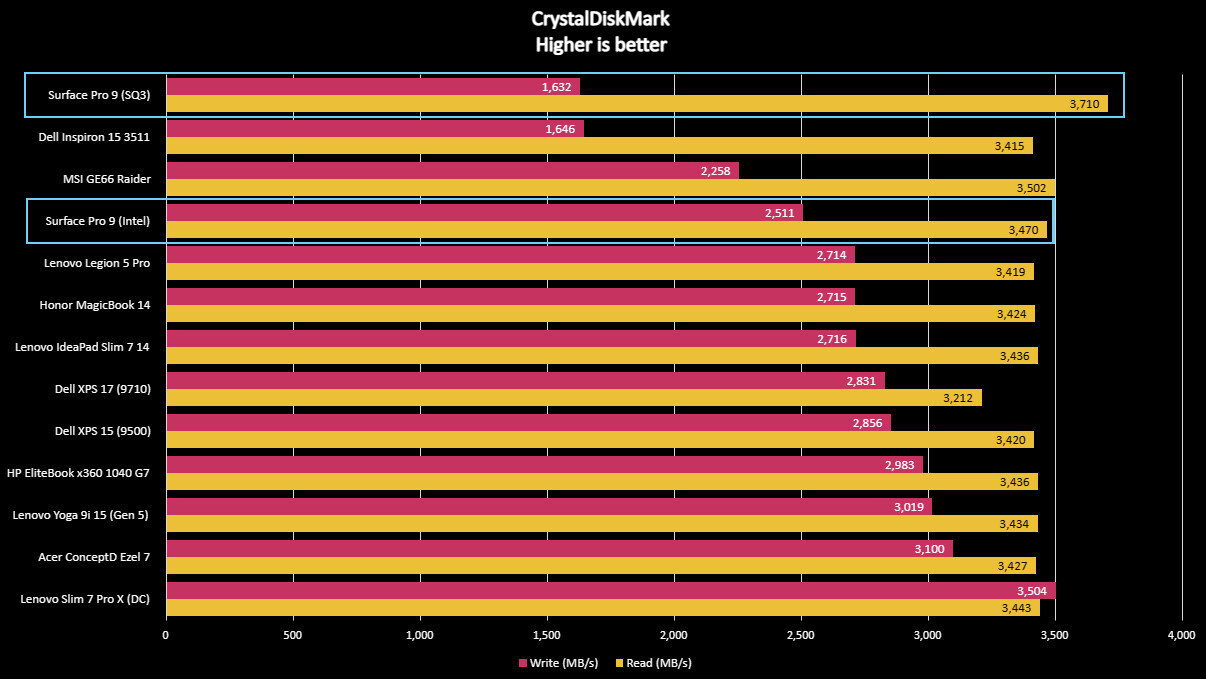

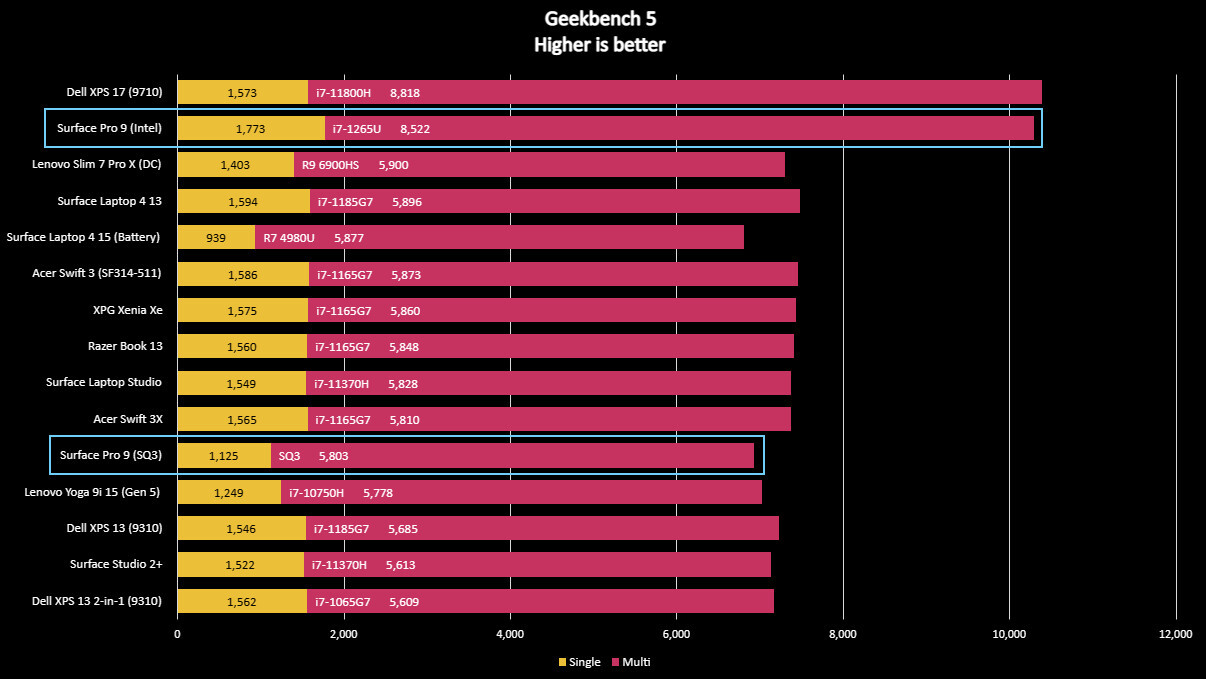
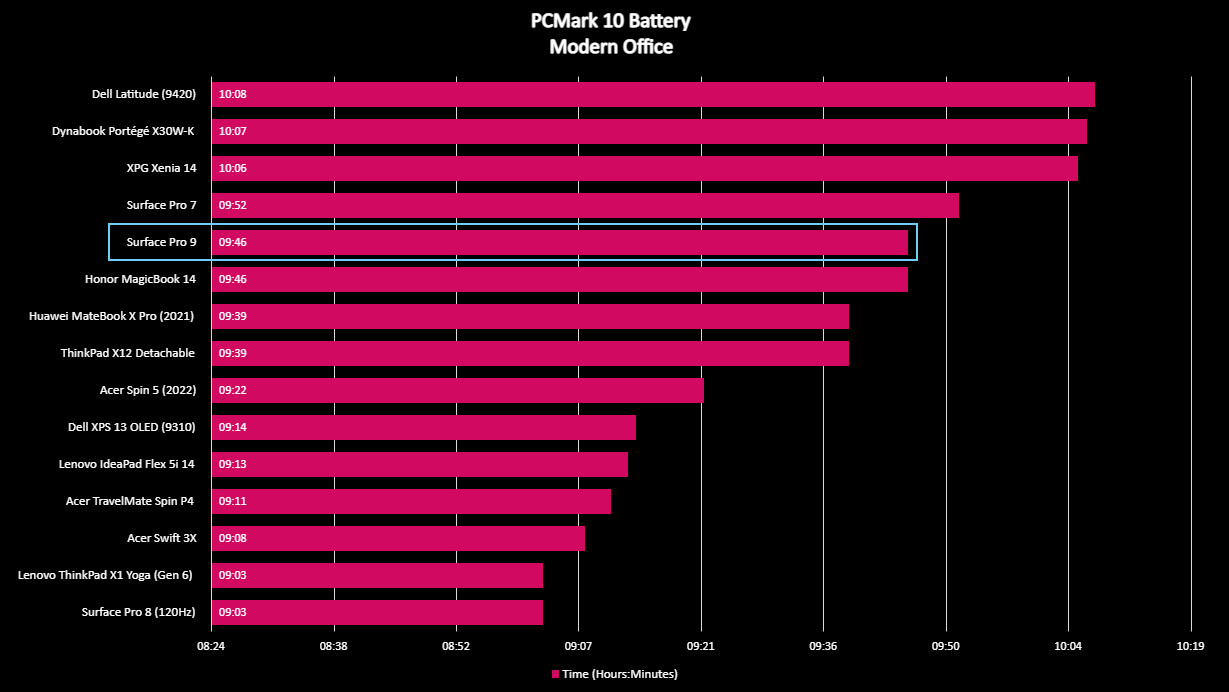
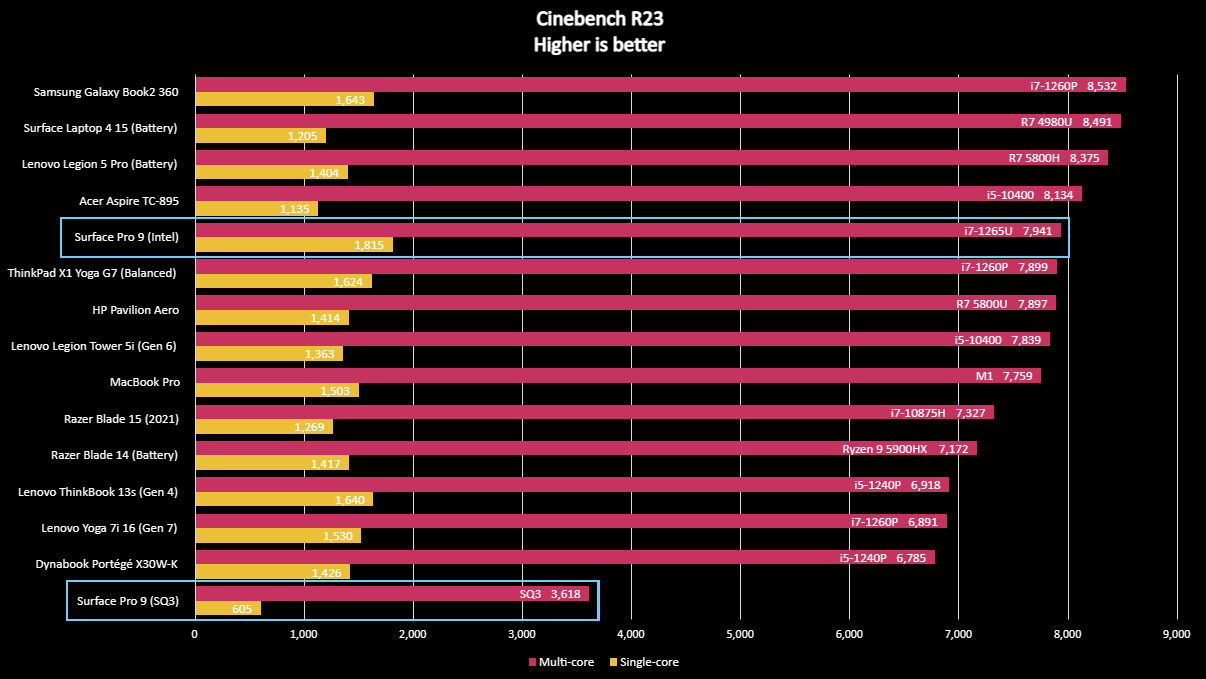
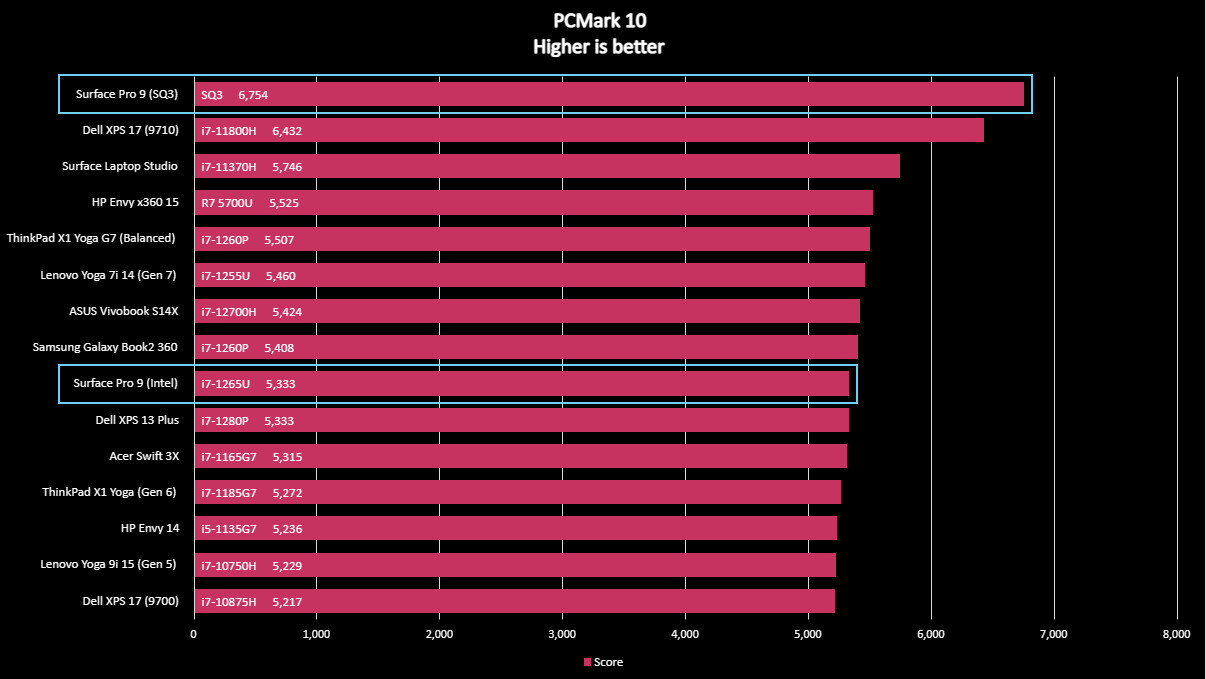
SSD performance is also great, though not best in class as devices like the Razer Book 13 still edge it out. With a 3,470MB/s read and 1,900MB/s write speed, the Surface Pro 9 will fly through most common tasks with no problems. It's a notable improvement over the Surface Pro 8's 2,390MB/s read, and 1,609MB/s write speeds too.
The only real let-down in performance with the Intel model is with the battery, though this seems to be the case with every Surface Pro. In our PCMark10 battery test, the Surface Pro 9 got a commendable 9 hours and 46 minutes, beating the Surface Pro 8 by close to 40 minutes. But real-world usage is often more like 6-7 hours in my testing.
You might be able to squeeze out an extra 30 minutes by using 60Hz mode, but you really won't get much more out of it. It's not the worst battery life you can find on a 2-in-1, but I'd say this is the only weak point in an otherwise excellent product.
With the Surface Pro 9 5G, things are a bit different. The Intel Core i7 model generates a Geekbench score of 1,773 for single-core and 8,522 for multi-core, whereas the Microsoft SQ3 model generates a score of 1,125 for single-core and 5,803 for multi-core. It's less powerful on paper, but this isn't something you really notice in day-to-day use unless running a heavy app under emulation.
The advantage of having a less powerful, more energy-efficient chip in the Surface Pro 9 with 5G is that battery life is generally a lot better. If I'm getting 7 hours on a good day with the Intel Surface Pro 9, the ARM Surface Pro 9 is able to stretch to something closer to 10 hours with no real effort.
Surface Pro 9: The competition
Curiously, competition in the 2-in-1 space has faded quite a bit as of late. While there are still plenty of laptop 2-in-1s, that being devices where the keyboard doesn't detach, you don't find many 2-in-1 devices that are tablets with an optional keyboard accessory like the Surface Pro 9.
The closest competitor to the Surface Pro 9 is the Surface Pro 8, which you can still find on sale at places like the Microsoft Store with its 11th-Generation Intel chips. It's even compatible with all the same accessories as the Surface Pro 9, too.
Elsewhere, we have the new Dell XPS 2-in-1, which is a Surface Pro clone with beautiful symmetrical bezels and a sharp external design. It has a very similar 13-inch display to the Surface Pro 9 as well, with a resolution of 2880 x 1920 and an aspect ratio of 3:2.
It's the same story in the silicon department, with the Dell XPS 2-in-1 offering both Intel Core i5 and Intel Core i7 12th-Gen chips, meaning the performance between these two devices is very similar. The biggest difference is with the design of the keyboard accessories. On the Surface Pro 9, the Type Cover attaches with magnets to the bottom of the device.
The Dell XPS 2-in-1 keyboard attaches like a case, which also includes a kickstand. So if you don't use the keyboard or case, your tablet is without the ability to stand on its own, as the Surface Pro 9's kickstand is integrated.
There's also the Lenovo ThinkPad X12, which is on the older side of things now with Intel 11th-Gen chips. This device was built with enterprise customers in mind, so it is less sexy on the design front but is still fully capable of things like pen support and face unlock.
It even has an integrated kickstand like the Surface Pro 9 and an optional keyboard accessory that attaches with magnets on the bottom.
Be sure to check out our roundup of the best Windows 2-in-1 laptops to find more competing products.
Surface Pro 9: Should you buy it?
You should buy the Surface Pro 9 if ...
- You want the best Windows 2-in-1 on the market
- You want a high-resolution 120Hz display
- You often draw or take notes using a digital pen
- You need a portable 2-in-1 that's excellent for travel
You should not buy the Surface Pro 9 if ...
- You need something with more powerful chips
- You prefer a traditional laptop form factor
- You need long battery life
I never used to be a fan of the Surface Pro line, but that all changed with the Surface Pro 9. This PC is amazing. I love the display. I love the design. I love the premium chassis. I love the Type Cover. The only thing I dislike is the battery life, which could be better. Almost everything about the Surface Pro 9 is perfect.
This is what ten years of refining the same core idea looks like. It's a tablet that also happens to be able to replace your laptop. The first Surface Pro was not very good at this, and up until now, the Surface Pro line was never able to keep up with my performance needs.
But with Intel 12th-Gen and the refined design of the Surface Pro 9, I say the Surface Pro 9 is a real laptop contender now. It's powerful and capable, portable and stylish. I want to take this out of my bag instead of a Surface Laptop 5 because it's just nicer and more mobile.
I also love the new colors for both the device and type covers. Sadly, I only got to review the silver model, but I was able to pair it with my own red Type Cover, which I think really pops in this combination.
If we gave the Surface Pro 8 and 4.5 out of 5. I think it's only fair that we give this one the full five stars. It's just that good.
Of course, in 2024 we now have the Surface Pro 11, which, naturally, I think is a better PC than the Surface Pro 9. However, now that the Surface Pro 9 is a couple of years old, you can find some great deals on it. You can likely save more than $500 by going for this slightly older model over the Surface Pro 11.

